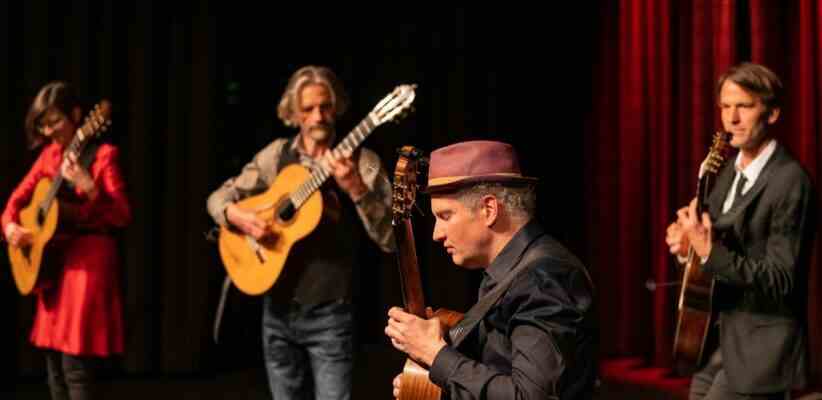There are five letters or, spoken, three syllables that let an endless spiral of associations grow: Maria. The ideas ignite from the greatness in the poverty of the stable, from the trace of loneliness that is around Our Lady or from the beauty of the woman who never ceases to inspire artists. For Anna Prüflinger, Maria stands for “the feminine, for courage and grace, for the mother, for strength and gentleness, for security, for hope and love”. And so go Perry Schack, Ingo Veit, Anna and Bernhard Prüflinger – in short: the Bad Tölzer Machado Quartet – in her latest album entitled “#Maria”, she explores the creative possibilities that open up when someone calls the Mother of God by her name.
In a musical tour from the Spanish composer Manuel De Falla to Bernhard Prüflinger’s own compositions, the guitar quartet shows their art of sophisticated tonal characterization. Here special women come to life as sound portraits, none like the other and not each sacred, but all elegant and of fragile beauty.
With “I say a little prayer” the quartet chose one of Aretha Franklin’s most tender creations. With the guitars of the Machado Quartet, she finds a new form that is able to express the melancholy without lyrics, but also the serenity that makes the Burt Bacharach song about love so timelessly topical in modern times. A relative has this voice in Astor Piazzolla’s María, the protagonist of his tango opera, which premiered in 1968. This Maria of the suburbs embodies the quartet with a somber halo, with the burning cold that characterizes Piazzolla’s music. The Argentinian may have a late relative in the clarinetist and composer David Orlowsky, with whose klezmer-tinged “July” the Machado Quartet can show its art of coordination. Every cheeky suggestion sits, every trill has its place.
The Machados find Manuel de Falla’s music no less true to style, which awakens associations with deep Spain, the “España profunda”, like hardly any other. The music from de Falla’s ballet “Der Dreispitz”, a story about a miller’s wife who keeps her married life through cleverness and moral steadfastness, is therefore performed in a wide variety of instrumentations. But the guitar versions in particular often suffer from overly aggressive access, from scrubbing the strings, which is often confused with authentic music-making of southern temperament. The Tölzer Quartet is far from that. Be it the roaring “Danza de la molinera” or the slightly moving “Danza de los vecinos”, the ensemble always maintains the noble balance and the sense for the fine contours, which earned them a second “Global Music Award” with this album brought in.
The heart of the collection of exquisite guitar music, however, are probably Bernhard Prüflinger’s four compositions, to which he gave the title “Lebenslieder”. The pieces are portraits of strong women in the composer’s life, four generations, a family tree that has become a sound, whose roots stretch back to the Ukraine: Zoe, the great-grandmother who was born in Kyiv, lost her mother and father at an early age, but did not give up the search for a family . The story of “four fates of people who happened to be children of their time” begins with cautious, groping, melancholic tones, as Prüflinger says.
More dynamic, more active, on the other hand, is Zhanna, Zoe’s daughter, an athlete who challenges the quartet’s feel for pounding rhythms. Sani, the musician’s wife, marked the beginning of the compositional history. He dedicated perhaps the most intimate piece of the series to her. The sound of the sea merges into a warm, spreading melodic landscape of the soul, presented on four guitars in unison. With Emilie, the composer’s daughter, the series comes to an appropriately optimistic conclusion with delicate phrases, sensitively phrased. Because, as Prüflinger emphasizes, the pieces are not just a family story, a musical journey from East to West (which is also reflected in the style), the musical design of a gradual brightening. No, the Lebenslieder are also a way of proving with music how close East Europe and Germany really are. In concrete terms: you create the most beautiful arc from Kyiv to the former barn wing of the Hahnhof in Großhartpenning, where the recordings were made.
Each portrait of Mary has a special character, as a weeping, enthroned, kind mother. Now one may decide for oneself whether the pieces really refer to Maria. It seems much more as if the Machado Quartet tried to use this name to find a cipher for everything possible that stands for itself as sensitive as it is self-confident, as individual as it is open-minded. They did it very well.

